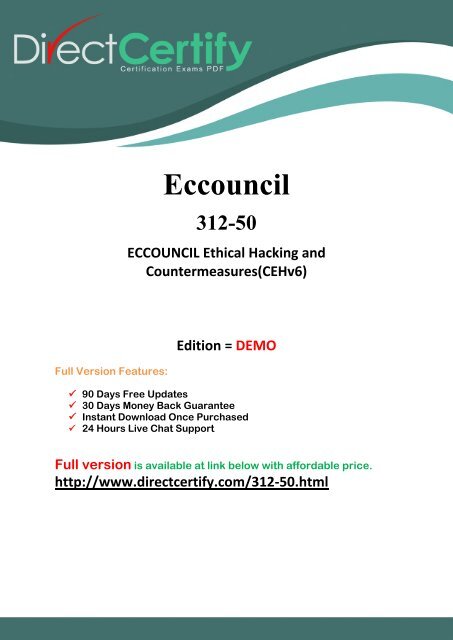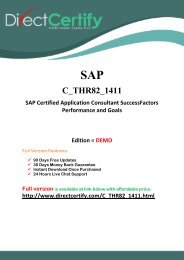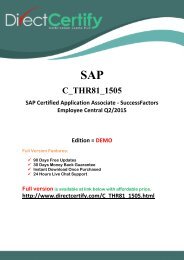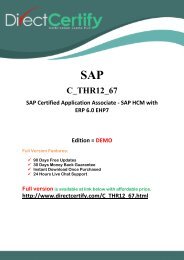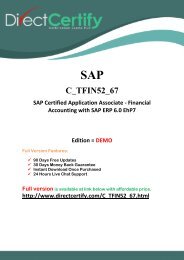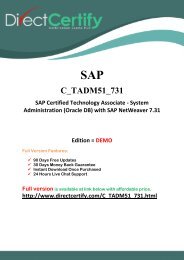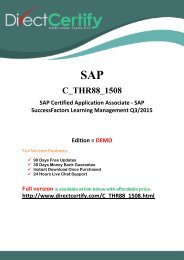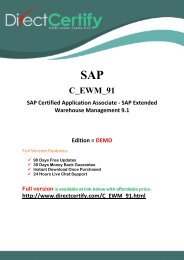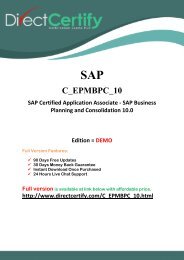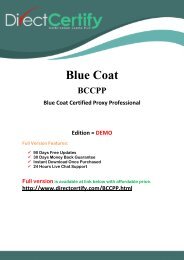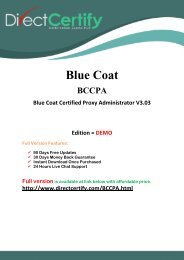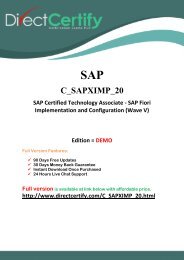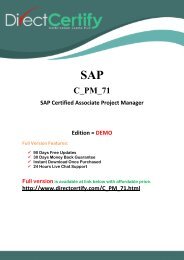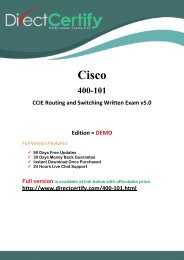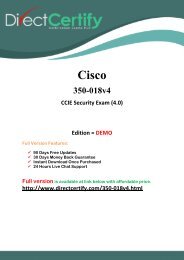DirectCertify 312-50 Latest Exam Brain Dumps
Get your future secure with our training kits of PDF questions answers which are verified and authorized by the experts and professionals regarding 312-50 Exam. For more info please visit here: http://www.directcertify.com/312-50.html
Get your future secure with our training kits of PDF questions answers which are verified and authorized by the experts and professionals regarding 312-50 Exam. For more info please visit here: http://www.directcertify.com/312-50.html
You also want an ePaper? Increase the reach of your titles
YUMPU automatically turns print PDFs into web optimized ePapers that Google loves.
Eccouncil<br />
<strong>312</strong>-<strong>50</strong><br />
ECCOUNCIL Ethical Hacking and<br />
Countermeasures(CEHv6)<br />
Full Version Features:<br />
Edition = DEMO<br />
90 Days Free Updates<br />
30 Days Money Back Guarantee<br />
Instant Download Once Purchased<br />
24 Hours Live Chat Support<br />
Full version is available at link below with affordable price.<br />
http://www.directcertify.com/<strong>312</strong>-<strong>50</strong>.html
www.<strong>DirectCertify</strong>.com IT Certification <strong>Exam</strong>sPDF<br />
Question: 1<br />
What is the essential difference between an ‘Ethical Hacker’ and a ‘Cracker’?<br />
A. The ethical hacker does not use the same techniques or skills as a cracker.<br />
B. The ethical hacker does it strictly for financial motives unlike a cracker.<br />
C. The ethical hacker has authorization from the owner of the target.<br />
D. The ethical hacker is just a cracker who is getting paid.<br />
Answer: C<br />
Explanation:<br />
The ethical hacker uses the same techniques and skills as a cracker and the motive is to find the<br />
security breaches before a cracker does. There is nothing that says that a cracker does not get paid<br />
for the work he does, a ethical hacker has the owners authorization and will get paid even if he does<br />
not succeed to penetrate the target.<br />
Question: 2<br />
What does the term “Ethical Hacking” mean?<br />
A. Someone who is hacking for ethical reasons.<br />
B. Someone who is using his/her skills for ethical reasons.<br />
C. Someone who is using his/her skills for defensive purposes.<br />
D. Someone who is using his/her skills for offensive purposes.<br />
Answer: C<br />
Explanation:<br />
Ethical hacking is only about defending your self or your employer against malicious persons by using<br />
the same techniques and skills.<br />
Question: 3<br />
Who is an Ethical Hacker?<br />
Page | 2<br />
http://www.directcertify.com/<strong>312</strong>-<strong>50</strong>.html
www.<strong>DirectCertify</strong>.com IT Certification <strong>Exam</strong>sPDF<br />
A. A person who hacks for ethical reasons<br />
B. A person who hacks for an ethical cause<br />
C. A person who hacks for defensive purposes<br />
D. A person who hacks for offensive purposes<br />
Answer: C<br />
Explanation:<br />
The Ethical hacker is a security professional who applies his hacking skills for defensive purposes.<br />
Question: 4<br />
What is "Hacktivism"?<br />
A. Hacking for a cause<br />
B. Hacking ruthlessly<br />
C. An association which groups activists<br />
D. None of the above<br />
Answer: A<br />
Explanation:<br />
The term was coined by author/critic Jason Logan King Sack in an article about media artist Shu Lea<br />
Cheang. Acts of hacktivism are carried out in the belief that proper use of code will have leveraged<br />
effects similar to regular activism or civil disobedience.<br />
Question: 5<br />
Where should a security tester be looking for information that could be used by an attacker against<br />
an organization? (Select all that apply)<br />
A. CHAT rooms<br />
B. WHOIS database<br />
C. News groups<br />
D. Web sites<br />
E. Search engines<br />
F. Organization’s own web site<br />
Page | 3<br />
http://www.directcertify.com/<strong>312</strong>-<strong>50</strong>.html
www.<strong>DirectCertify</strong>.com IT Certification <strong>Exam</strong>sPDF<br />
Answer: A, B, C, D,<br />
E, F<br />
Explanation:<br />
A Security tester should search for information everywhere that he/she can access. You never know<br />
where you find that small piece of information that could penetrate a strong defense.<br />
Question: 6<br />
What are the two basic types of attacks?(Choose two.<br />
A. DoS<br />
B. Passive<br />
C. Sniffing<br />
D. Active<br />
E. Cracking<br />
Answer: B, D<br />
Explanation:<br />
Passive and active attacks are the two basic types of attacks.<br />
Question: 7<br />
The United Kingdom (UK) he passed a law that makes hacking into an unauthorized network a<br />
felony.<br />
The law states:<br />
Section1 of the Act refers to unauthorized access to computer material. This states that a person<br />
commits an offence if he causes a computer to perform any function with intent to secure<br />
unauthorized access to any program or data held in any computer. For a successful conviction under<br />
this part of the Act, the prosecution must prove that the access secured is unauthorized and that<br />
the suspect knew that this was the case. This section is designed to deal with common-or-graden<br />
hacking.<br />
Section 2 of the deals with unauthorized access with intent to commit or facilitate the commission of<br />
further offences. An offence is committed under Section 2 if a Section 1 offence has been committed<br />
and there is the intention of committing or facilitating a further offense (any offence which attacks a<br />
custodial sentence of more than five years, not necessarily one covered but the Act). Even if it is not<br />
possible to prove the intent to commit the further offence, the Section 1 offence is still committed.<br />
Section 3 Offences cover unauthorized modification of computer material, which generally means<br />
the creation and distribution of viruses. For conviction to succeed there must have been the intent<br />
to cause the modifications and knowledge that the modification had not been authorized<br />
What is the law called?<br />
Page | 4<br />
http://www.directcertify.com/<strong>312</strong>-<strong>50</strong>.html
www.<strong>DirectCertify</strong>.com IT Certification <strong>Exam</strong>sPDF<br />
A. Computer Misuse Act 1990<br />
B. Computer incident Act 2000<br />
C. Cyber Crime Law Act 2003<br />
D. Cyber Space Crime Act 1995<br />
Answer: A<br />
Explanation:<br />
Computer Misuse Act (1990) creates three criminal offences:<br />
1. Unauthorised access to computer material<br />
2. Unauthorised access to a computer system with intent to commit or facilitate the commission of a<br />
further offence<br />
3. Unauthorised modification of computer material<br />
Question: 8<br />
Which of the following best describes Vulnerability?<br />
A. The loss potential of a threat<br />
B. An action or event that might prejudice security<br />
C. An agent that could take advantage of a weakness<br />
D. A weakness or error that can lead to compromise<br />
Answer: D<br />
Explanation:<br />
A vulnerability is a flaw or weakness in system security procedures, design or implementation that<br />
could be exercised (accidentally triggered or intentionally exploited) and result in a harm to an IT<br />
system or activity.<br />
Question: 9<br />
Steven works as a security consultant and frequently performs penetration tests for Fortune <strong>50</strong>0<br />
companies. Steven runs external and internal tests and then creates reports to show the companies<br />
where their weak areas are. Steven always signs a non-disclosure agreement before performing his<br />
tests. What would Steven be considered?<br />
A. Whitehat Hacker<br />
B. BlackHat Hacker<br />
Page | 5<br />
http://www.directcertify.com/<strong>312</strong>-<strong>50</strong>.html
www.<strong>DirectCertify</strong>.com IT Certification <strong>Exam</strong>sPDF<br />
C. Grayhat Hacker<br />
D. Bluehat Hacker<br />
Answer: A<br />
Explanation:<br />
A white hat hacker, also rendered as ethical hacker, is, in the realm of information technology, a<br />
person who is ethically opposed to the abuse of computer systems. Realization that the Internet<br />
now represents human voices from around the world has made the defense of its integrity an<br />
important pastime for many. A white hat generally focuses on securing IT systems, whereas a black<br />
hat (the opposite) would like to break into them.<br />
Question: 10<br />
Which of the following act in the united states specifically criminalizes the transmission of<br />
unsolicited commercial e-mail(SPAM) without an existing business relationship.<br />
A. 2004 CANSPAM Act<br />
B. 2003 SPAM Preventing Act<br />
C. 2005 US-SPAM 1030 Act<br />
D. 1990 Computer Misuse Act<br />
Answer: A<br />
Explanation:<br />
The CAN-SPAM Act of 2003 (Controlling the Assault of Non-Solicited Pornography and Marketing<br />
Act) establishes requirements for those who send commercial email, spells out penalties for<br />
spammers and companies whose products are advertised in spam if they violate the law, and gives<br />
consumers the right to ask emailers to stop spamming them. The law, which became effective<br />
January 1, 2004, covers email whose primary purpose is advertising or promoting a commercial<br />
product or service, including content on a Web site. A "transactional or relationship message" –<br />
email that facilitates an agreed-upon transaction or updates a customer in an existing business<br />
relationship – may not contain false or misleading routing information, but otherwise is exempt from<br />
most provisions of the CAN-SPAM Act.<br />
Question: 11<br />
ABC.com is legally liable for the content of email that is sent from its systems, regardless of whether<br />
the message was sent for private or business-related purpose. This could lead to prosecution for the<br />
Page | 6<br />
http://www.directcertify.com/<strong>312</strong>-<strong>50</strong>.html
www.<strong>DirectCertify</strong>.com IT Certification <strong>Exam</strong>sPDF<br />
sender and for the company’s directors if, for example, outgoing email was found to contain<br />
material that was pornographic, racist or likely to incite someone to commit an act of terrorism.<br />
You can always defend yourself by “ignorance of the law” clause.<br />
A. True<br />
B. False<br />
Answer: B<br />
Explanation:Ignorantia juris non excusat or Ignorantia legis neminem excusat (Latin for "ignorance of<br />
the law does not excuse" or "ignorance of the law excuses no one") is a public policy holding that a<br />
person who is unaware of a law may not escape liability for violating that law merely because he or<br />
she was unaware of its content; that is, persons have presumed knowledge of the law. Presumed<br />
knowledge of the law is the principle in jurisprudence that one is bound by a law even if one does<br />
not know of it. It has also been defined as the "prohibition of ignorance of the law".<br />
Question: 12<br />
You are footprinting Acme.com to gather competitive intelligence. You visit the acme.com websire<br />
for contact information and telephone number numbers but do not find it listed there. You know<br />
that they had the entire staff directory listed on their website 12 months ago but now it is not there.<br />
How would it be possible for you to retrieve information from the website that is outdated?<br />
A. Visit google search engine and view the cached copy.<br />
B. Visit Archive.org site to retrieve the Internet archive of the acme website.<br />
C. Crawl the entire website and store them into your computer.<br />
D. Visit the company’s partners and customers website for this information.<br />
Answer: B<br />
Explanation:<br />
The Internet Archive (IA) is a non-profit organization dedicated to maintaining an archive of Web and<br />
multimedia resources. Located at the Presidio in San Francisco, California, this archive includes<br />
"snapshots of the World Wide Web" (archived copies of pages, taken at various points in time),<br />
software, movies, books, and audio recordings (including recordings of live concerts from bands that<br />
allow it). This site is found at www.archive.org.<br />
Question: 13<br />
Page | 7<br />
http://www.directcertify.com/<strong>312</strong>-<strong>50</strong>.html
www.<strong>DirectCertify</strong>.com IT Certification <strong>Exam</strong>sPDF<br />
User which Federal Statutes does FBI investigate for computer crimes involving e-mail scams and<br />
mail fraud?<br />
A. 18 U.S.C 1029 Possession of Access Devices<br />
B. 18 U.S.C 1030 Fraud and related activity in connection with computers<br />
C. 18 U.S.C 1343 Fraud by wire, radio or television<br />
D. 18 U.S.C 1361 Injury to Government Property<br />
E. 18 U.S.C 1362 Government communication systems<br />
F. 18 U.S.C 1831 Economic Espionage Act<br />
G. 18 U.S.C 1832 Trade Secrets Act<br />
Answer: B<br />
Explanation:<br />
http://www.law.cornell.edu/uscode/html/uscode18/usc_sec_18_00001030----000-.html<br />
Question: 14<br />
Which of the following activities will NOT be considered as passive footprinting?<br />
A. Go through the rubbish to find out any information that might have been discarded.<br />
B. Search on financial site such as Yahoo Financial to identify assets.<br />
C. Scan the range of IP address found in the target DNS database.<br />
D. Perform multiples queries using a search engine.<br />
Answer: C<br />
Explanation:<br />
Passive footprinting is a method in which the attacker never makes contact with the target systems.<br />
Scanning the range of IP addresses found in the target DNS is considered making contact to the<br />
systems behind the IP addresses that is targeted by the scan.<br />
Question: 15<br />
Which one of the following is defined as the process of distributing incorrect Internet Protocol (IP)<br />
addresses/names with the intent of diverting traffic?<br />
A. Network aliasing<br />
B. Domain Name Server (DNS) poisoning<br />
C. Reverse Address Resolution Protocol (ARP)<br />
Page | 8<br />
http://www.directcertify.com/<strong>312</strong>-<strong>50</strong>.html
www.<strong>DirectCertify</strong>.com IT Certification <strong>Exam</strong>sPDF<br />
D. Port scanning<br />
Answer: B<br />
Explanation:<br />
This reference is close to the one listed DNS poisoning is the correct answer.<br />
This is how DNS DOS attack can occur. If the actual DNS records are unattainable to the attacker for<br />
him to alter in this fashion, which they should be, the attacker can insert this data into the cache of<br />
there server instead of replacing the actual records, which is referred to as cache poisoning.<br />
Question: 16<br />
You are footprinting an organization to gather competitive intelligence. You visit the company’s<br />
website for contact information and telephone numbers but do not find it listed there. You know<br />
that they had the entire staff directory listed on their website 12 months ago but not it is not there.<br />
How would it be possible for you to retrieve information from the website that is outdated?<br />
A. Visit google’s search engine and view the cached copy.<br />
B. Visit Archive.org web site to retrieve the Internet archive of the company’s website.<br />
C. Crawl the entire website and store them into your computer.<br />
D. Visit the company’s partners and customers website for this information.<br />
Answer: B<br />
Explanation:<br />
Archive.org mirrors websites and categorizes them by date and month depending on the crawl time.<br />
Archive.org dates back to 1996, Google is incorrect because the cache is only as recent as the latest<br />
crawl, the cache is over-written on each subsequent crawl. Download the website is incorrect<br />
because that's the same as what you see online. Visiting customer partners websites is just bogus.<br />
The answer is then Firmly, C, archive.org<br />
Question: 17<br />
A Company security System Administrator is reviewing the network system log files. He notes the<br />
following:<br />
- Network log files are at 5 MB at 12:00 noon.<br />
- At 14:00 hours, the log files at 3 MB.<br />
What should he assume has happened and what should he do about the situation?<br />
A. He should contact the attacker’s ISP as soon as possible and have the connection disconnected.<br />
Page | 9<br />
http://www.directcertify.com/<strong>312</strong>-<strong>50</strong>.html
www.<strong>DirectCertify</strong>.com IT Certification <strong>Exam</strong>sPDF<br />
B. He should log the event as suspicious activity, continue to investigate, and take further steps<br />
according to site security policy.<br />
C. He should log the file size, and archive the information, because the router crashed.<br />
D. He should run a file system check, because the Syslog server has a self correcting file system<br />
problem.<br />
E. He should disconnect from the Internet discontinue any further unauthorized use, because an<br />
attack has taken place.<br />
Answer: B<br />
Explanation:<br />
You should never assume a host has been compromised without verification. Typically,<br />
disconnecting a server is an extreme measure and should only be done when it is confirmed there is<br />
a compromise or the server contains such sensitive data that the loss of service outweighs the risk.<br />
Never assume that any administrator or automatic process is making changes to a system. Always<br />
investigate the root cause of the change on the system and follow your organizations security policy.<br />
Question: 18<br />
To what does “message repudiation” refer to what concept in the realm of email security?<br />
A. Message repudiation means a user can validate which mail server or servers a message was<br />
passed through.<br />
B. Message repudiation means a user can claim damages for a mail message that damaged their<br />
reputation.<br />
C. Message repudiation means a recipient can be sure that a message was sent from a particular<br />
person.<br />
D. Message repudiation means a recipient can be sure that a message was sent from a certain host.<br />
E. Message repudiation means a sender can claim they did not actually send a particular message.<br />
Answer: E<br />
Explanation:<br />
A quality that prevents a third party from being able to prove that a communication between two<br />
other parties ever took place. This is a desirable quality if you do not want your communications to<br />
be traceable.<br />
Non-repudiation is the opposite quality—a third party can prove that a communication between two<br />
other parties took place. Non-repudiation is desirable if you want to be able to trace your<br />
communications and prove that they occurred. Repudiation – Denial of message submission or<br />
delivery.<br />
Page | 10<br />
http://www.directcertify.com/<strong>312</strong>-<strong>50</strong>.html
www.<strong>DirectCertify</strong>.com IT Certification <strong>Exam</strong>sPDF<br />
Question: 19<br />
How does Traceroute map the route that a packet travels from point A to point B?<br />
A. It uses a TCP Timestamp packet that will elicit a time exceed in transit message.<br />
B. It uses a protocol that will be rejected at the gateways on its way to its destination.<br />
C. It manipulates the value of time to live (TTL) parameter packet to elicit a time exceeded in transit<br />
message.<br />
D. It manipulated flags within packets to force gateways into generating error messages.<br />
Answer: C<br />
Explanation:Traceroute works by increasing the "time-to-live" value of each successive batch of<br />
packets sent. The first three packets have a time-to-live (TTL) value of one (implying that they make<br />
a single hop). The next three packets have a TTL value of 2, and so on. When a packet passes through<br />
a host, normally the host decrements the TTL value by one, and forwards the packet to the next<br />
host. When a packet with a TTL of one reaches a host, the host discards the packet and sends an<br />
ICMP time exceeded (type 11) packet to the sender. The traceroute utility uses these returning<br />
packets to produce a list of hosts that the packets have traversed en route to the destination.<br />
Question: 20<br />
Snort has been used to capture packets on the network. On studying the packets, the penetration<br />
tester finds it to be abnormal. If you were the penetration tester, why would you find this abnormal?<br />
(Note: The student is being tested on concept learnt during passive OS fingerprinting, basic TCP/IP<br />
connection concepts and the ability to read packet signatures from a sniff dumo.)<br />
05/20-17:06:45.061034 192.160.13.4:31337 -> 172.16.1.101:1<br />
TCP TTL:44 TOS:0x10 ID:242<br />
***FRP** Seq: 0XA1D95 Ack: 0x53 Win: 0x400<br />
.<br />
.<br />
.<br />
05/20-17:06:58.685879 192.160.13.4:31337 -> 172.16.1.101:1024<br />
TCP TTL:44 TOS:0x10 ID:242<br />
***FRP** Seg: 0XA1D95 Ack: 0x53 Win: 0x400<br />
What is odd about this attack? (Choose the most appropriate statement)<br />
A. This is not a spoofed packet as the IP stack has increasing numbers for the three flags.<br />
B. This is back orifice activity as the scan comes from port 31337.<br />
C. The attacker wants to avoid creating a sub-carrier connection that is not normally valid.<br />
D. There packets were created by a tool; they were not created by a standard IP stack.<br />
Page | 11<br />
http://www.directcertify.com/<strong>312</strong>-<strong>50</strong>.html
www.<strong>DirectCertify</strong>.com IT Certification <strong>Exam</strong>sPDF<br />
Answer: B<br />
Explanation:<br />
Port 31337 is normally used by Back Orifice. Note that 31337 is hackers spelling of ‘elite’, meaning<br />
‘elite hackers’.<br />
Question: 21<br />
Your company trainee Sandra asks you which are the four existing Regional Internet Registry (RIR's)?<br />
A. APNIC, PICNIC, ARIN, LACNIC<br />
B. RIPE NCC, LACNIC, ARIN, APNIC<br />
C. RIPE NCC, NANIC, ARIN, APNIC<br />
D. RIPE NCC, ARIN, APNIC, LATNIC<br />
Answer: B<br />
Explanation:<br />
All other answers include non existing organizations (PICNIC, NANIC, LATNIC). See<br />
http://www.arin.net/library/internet_info/ripe.html<br />
Question: 22<br />
A very useful resource for passively gathering information about a target company is:<br />
A. Host scanning<br />
B. Whois search<br />
C. Traceroute<br />
D. Ping sweep<br />
Answer: B<br />
Explanation:<br />
A, C & D are "Active" scans, the question says: "Passively"<br />
Question: 23<br />
Page | 12<br />
http://www.directcertify.com/<strong>312</strong>-<strong>50</strong>.html
www.<strong>DirectCertify</strong>.com IT Certification <strong>Exam</strong>sPDF<br />
You receive an email with the following message:<br />
Hello Steve,<br />
We are having technical difficulty in restoring user database record after the recent blackout. Your<br />
account data is corrupted. Please logon to the SuperEmailServices.com and change your password.<br />
http://www.supermailservices.com@0xde.0xad.0xbe.0xef/support/logon.htm<br />
If you do not reset your password within 7 days, your account will be permanently disabled locking<br />
you out from our e-mail services.<br />
Sincerely,<br />
Technical Support<br />
SuperEmailServices<br />
From this e-mail you suspect that this message was sent by some hacker since you have been using<br />
their e-mail services for the last 2 years and they have never sent out an e-mail such as this. You also<br />
observe the URL in the message and confirm your suspicion about 0xde.0xad.0xbde.0xef which looks<br />
like hexadecimal numbers. You immediately enter the following at Windows 2000 command<br />
prompt:<br />
Ping 0xde.0xad.0xbe.0xef<br />
You get a response with a valid IP address.<br />
What is the obstructed IP address in the e-mail URL?<br />
A. 222.173.190.239<br />
B. 233.34.45.64<br />
C. 54.23.56.55<br />
D. 199.223.23.45<br />
Answer: A<br />
Explanation:<br />
0x stands for hexadecimal and DE=222, AD=173, BE=190 and EF=239<br />
Question: 24<br />
Which of the following tools are used for footprinting?(Choose four.<br />
A. Sam Spade<br />
B. NSLookup<br />
C. Traceroute<br />
D. Neotrace<br />
E. Cheops<br />
Answer: A, B, C, D<br />
Page | 13<br />
http://www.directcertify.com/<strong>312</strong>-<strong>50</strong>.html
www.<strong>DirectCertify</strong>.com IT Certification <strong>Exam</strong>sPDF<br />
Explanation:<br />
All of the tools listed are used for footprinting except Cheops.<br />
Question: 25<br />
According to the CEH methodology, what is the next step to be performed after footprinting?<br />
A. Enumeration<br />
B. Scanning<br />
C. System Hacking<br />
D. Social Engineering<br />
E. Expanding Influence<br />
Answer: B<br />
Page | 14<br />
http://www.directcertify.com/<strong>312</strong>-<strong>50</strong>.html
www.<strong>DirectCertify</strong>.com IT Certification <strong>Exam</strong>sPDF<br />
Full version is available at link below with affordable price.<br />
http://www.directcertify.com/<strong>312</strong>-<strong>50</strong>.html<br />
15% Discount Coupon Code: D39Z55X994<br />
Full Product Includes.<br />
Thank You for Using Our PDF:<br />
Page | 15<br />
http://www.directcertify.com/<strong>312</strong>-<strong>50</strong>.html


